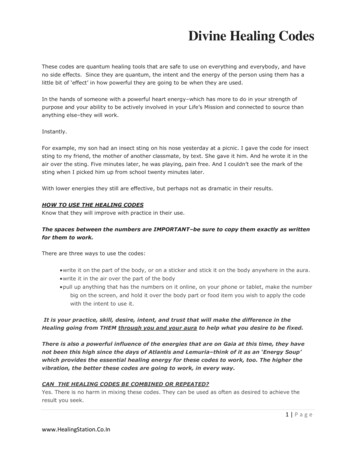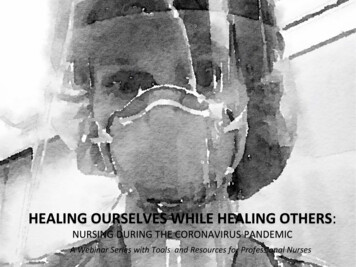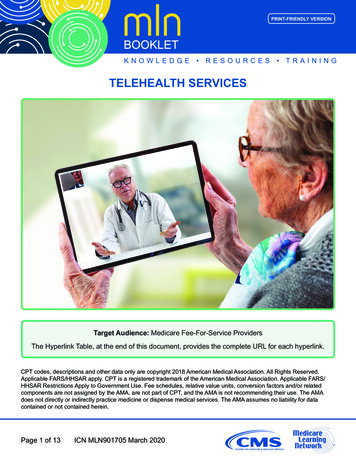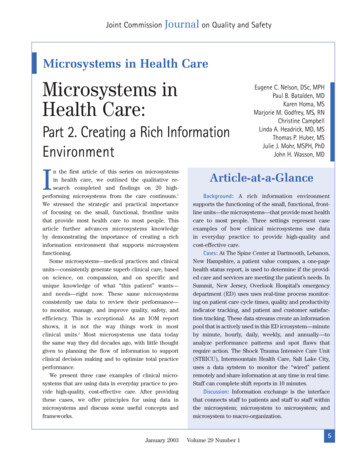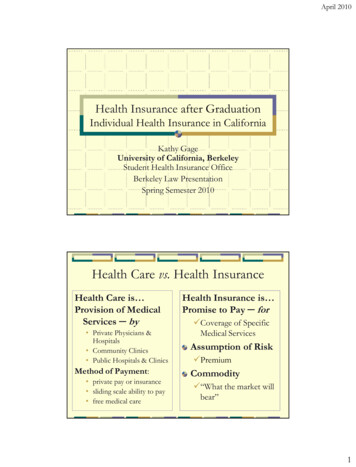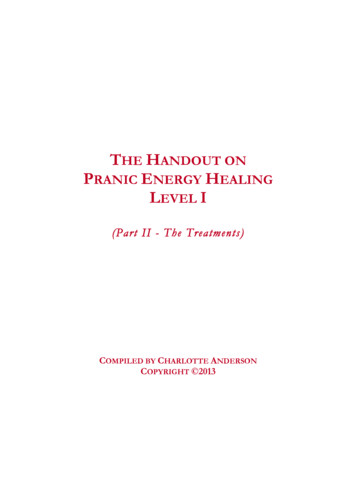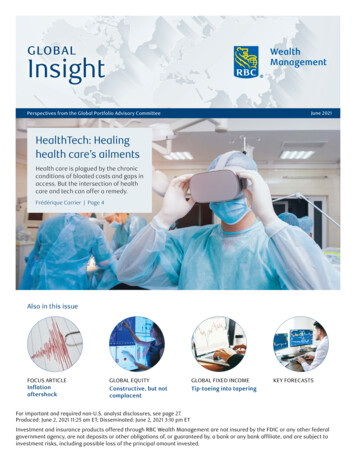
Transcription
GLOBALInsightJune 2021Perspectives from the Global Portfolio Advisory CommitteeHealthTech: Healinghealth care’s ailmentsHealth care is plagued by the chronicconditions of bloated costs and gaps inaccess. But the intersection of healthcare and tech can offer a remedy.Frédérique Carrier Page 4Also in this issueFOCUS ARTICLEGLOBAL EQUITYGLOBAL FIXED INCOMEInflationaftershockConstructive, but notcomplacentTip-toeing into taperingKEY FORECASTSFor important and required non-U.S. analyst disclosures, see page 27.Produced: June 2, 2021 11:25 am ET; Disseminated: June 2, 2021 3:10 pm ETInvestment and insurance products offered through RBC Wealth Management are not insured by the FDIC or any other federalgovernment agency, are not deposits or other obligations of, or guaranteed by, a bank or any bank affiliate, and are subject toinvestment risks, including possible loss of the principal amount invested.
GLOBALInsightJune 2021CONTENTS4HealthTech: Healing health care’s ailmentsWith bloated costs and gaps in access to quality services, the traditional healthcare model is plagued by its own chronic conditions. But at the intersection ofhealth care and technology, we’re seeing the development of a remedy for whatails health care. We look at the change that is afoot and what it means for theinvestment landscape.13Inflation aftershockThe COVID-19 earthquake has had a seismic effect on the U.S. economy. Withbusinesses now reopening, aftershocks are being felt. Inflation has surfaced forthe first time in years. The report takes a look at the risks associated with risingconsumer prices, including how inflation could impact the equity market.20 Global equity: Constructive, but not complacentWhile no bear market appears in sight, corrections are another matter. We seeat least three risks that could induce volatility. But that would be something tobe endured on the way to further worthwhile gains as the economic expansionplays out.22 Global fixed income: Tip-toeing into taperingThe June meetings of the Fed and European Central Bank may offer moreinformation regarding tapering asset purchases. We maintain our view thatkey global central banks will take a highly cautious approach to removingaccommodation no matter how strong the recovery.IN THE MARKETSAll values in U.S. dollars and priced asof market close, May 31, 2021, unlessotherwise stated.3RBC’s investment stance20Global equity22Global fixed income24Key forecasts25Market scorecard
Global Insight, June 2021Page 3 of 29EQUITIESRBC’S INVESTMENT The COVID-19 pandemic may not be entirely over, but the accelerated paceof vaccination rollouts in most countries should ensure at least partialeconomic reopenings, though those could be vulnerable to any resurgence ofthe virus, as has been seen in some Asian countries.Stance We would continue to maintain an above-benchmark position in globalequities. While the reopening of economies may be rocky and uneven attimes, we think it will nonetheless lend support to corporate earnings, whichshould continue to recover. We expect most central banks to tread carefullyand either message very adroitly any upcoming reduction in monetarysupport or remain dovish.Global asset class viewsAssetClassView– xEquitiesFixedIncome With economic growth above average in 2021, we would maintain a biastoward value stocks. Moreover, we have upgraded European equities to anOverweight position as that economy has proved surprisingly resilient, andwe believe valuations appear attractive.xFIXED erageperformance( / /–) represents the Global PortfolioAdvisory Committee’s (GPAC) view overa 12-month investment time horizon. Overweight implies the potential forbetter-than-average performance forthe asset class or for the region relativeto other asset classes or regions. Market Weight implies the potentialfor average performance for the assetclass or for the region relative to otherasset classes or regions.– Underweight implies the potentialfor below-average performance for theasset class or for the region relative toother asset classes or regions.Source - RBC Wealth Management Global yields have yet to break out of recent trading ranges as globalcentral banks broadly continue to push back against the idea that near-terminflation pressures or economic reopening optimism may force them towithdraw policy accommodation sooner than expected. However, while thetapering of asset purchases seems to be on hold for the time being, bankersmay only be delaying the inevitable as the next phase of monetary policyis seen coming into focus over the course of the summer. We favor shortermaturities in government debt as we continue to position for modestly higheryields in the back half of the year as central banks approach the point ofreducing bond buying programs. In credit markets, valuations are historicallyrich and corporate bond yields remain near record lows, but we still expectcredit to outperform government debt in 2021. We maintain our Market Weight in global fixed income, but continue toreduce interest rate risk exposure as global yields rise on a continuedrepricing of a strong economic recovery. We maintain a modest Overweightto corporate credit, primarily via preferred shares.
Page 4 of 29Global Insight, June 2021MONTHLYFocusFrédérique CarrierLondon, UKfrederique.carrier@rbc.comHealthTech: Healing health care’sailmentsWith bloated costs and gaps in access to quality services, thetraditional health care model is plagued by its own chronicconditions. But at the intersection of health care and technology,we’re seeing the development of a remedy for what ails healthcare. We look at the change that is afoot and what it means forthe investment landscape.Rising health care costs and unequal access to care are widespread,chronic challenges, even more so now as populations are becoming greyerthroughout the world and have ever greater medical needs. Demand forhealth care solutions is growing apace and seems unlikely to slow down. Thiscompounding burden on the world’s health care systems is not sustainable.HealthTech, the convergence of health care and technology, has thepotential to meaningfully reduce costs and improve efficiencies. We believeboth will be needed in large measure to ensure a more sustainable healthcare spending path and to improve the quality of health care servicesdelivered.Resisting changeWhile many industries, such as autos and entertainment, have embracedthe digital age, swiftly transforming in the process, health care has beena glaring exception. Several barriers have conspired to slow the adoptionof new technologies, blocking consequential change: Stringent regulatoryrequirements; the need for a secure, personal connection betweenphysician and patients; the natural tendency of health care organizationsto resist change, perhaps due to the relatively advanced average age ofdoctors; and a track record of failing to implement ambitious informationtechnology (IT) projects.Japan is a case in point. Despite its high-tech reputation, the country rankslast for management and use of data in health care within the Organizationfor Economic Cooperation and Development (OECD), a group of mostlyrich countries. There has been opposition from the medical profession onprivacy concerns, while an aging population—with more than a quarter ofthe population older than 65 (vs. 15 percent in the U.S.)—has also provedto be a hurdle. Yet forces are increasingly in place for digitization to finallytake root in that country and elsewhere.Change is neededSwelling health care costs are one reason to look to improve the efficiencyof health care delivery. Moreover, according to the OECD, as much asone-fifth of health care spending is wasted, and it surmises that the sameservices could be provided with fewer resources. With most governments
Global Insight, June 2021In the U.S., the government contribution to health care costs is less,according to the Centers for Medicare & Medicaid Services (CMS), withboth federal and state governments financing a lower 37 percent of theannual health care spend. But private health insurance companies, whichfinance 34 percent, and those who pay out of pocket (10 percent) are allequally keen to see their bills shrink, along with an improvement in healthoutcomes.The U.S. also stands out with health care expenditures that are a high 17percent of GDP, compared to an average for other advanced economiesthat is closer to 10 percent. This would be easier to accept if the healthoutcomes achieved were commensurately better. But the table on the nextpage reveals that on a number of measures the U.S. scores at the bottomof the OECD peer group.U.S. health care spending is far above other nations, and risingHealth care spending as a percentage of GDP, 1980–201918%U.S., 17.0%16%Switzerland, 12.2%Germany, 11.5%14%France, 11.2%12%Sweden, 10.9%Canada, 10.8%10%Norway, 10.5%8%UK, 10.3%20192016201320102007200420011998Australia, 9.3%19954%1992Netherlands, 10.0%19896%1986HealthTech: Healing health care’sailments1983MONTHLY FOCUSin OECD countries footing the bill for as much as three-quarters of healthcare costs, such waste undermines the financial sustainability of healthcare systems. Plainly, the incentive to improve is high.1980Page 5 of 29Source - OECD Health Data, OECD.Stat; 2019 data are provisional or estimatedThis creates an interesting dynamic: the U.S. has the most to gain on bothfronts—bringing costs down and improving outcomes. The U.S. is alsohome to the deepest, most diverse corporate health care sector. Properlyincentivized, it should be the source of much of the HealthTech innovationin the coming decade with a potential customer base that could include allthe developed economies.Change is afootA new model is emerging in which patients are the central health caredecision-maker, replacing the traditional model where doctors andpharmaceutical companies are in the driver’s seat. This has been madepossible by recent advances in big data and artificial intelligence (AI).Big Tech and surprisingly well-funded start-ups are now challenging theincumbents. RBC Capital Markets’ health care analysts note that theformer benefits from an aggregate 500 billion in balance sheet cash, ormore than twice that of the combined top-20 global health care companies;
Page 6 of 29Global Insight, June 2021MONTHLY FOCUSHealthTech: Healing health care’sailmentsthe latter is backed by private investment which is accelerating at recordlevels, with over 9 billion raised in just the first nine months of 2020amidst the pandemic.This new model was gaining traction when the COVID-19 pandemic struck.With hospitals turning away patients requiring other treatments, andlockdowns forcing lifestyle changes, the trends became entrenched. As theworld returns to normal, we believe some of the changes implemented bythe medical professions during the pandemic are here to stay, particularlyfor routine outpatient visits and treatment of infectious diseases such asthe flu. Thanks to remote care, those suffering from the flu will pose lessof a risk to other patients or medical staff. Moreover, the way consumersshop for care and wellness is changing for good.The evolving landscape has caught the eye of regulators, who arebecoming increasingly supportive. Last year, spurred by the ravages ofCOVID-19, the CMS announced that the U.S.’s Medicare program, whichserves more than 60 million elderly, would allow online patient visits.Canada’s single-payer system moved to allow family physicians to bereimbursed for telephone consultations.In September 2020, the U.S. Food and Drug Administration announced thelaunch of the Digital Health Center of Excellence. The initiative is gearedtoward digital health products, such as smartphone apps, wearabledevices, and software-based treatments, and is part of an effort tomodernize digital health policies, regulatory approaches, and tools.U.S. outcomes surprisingly poor given the high cost of health careSelected health care outcomes in OECD countriesHealth outcomesPoor U.S.healthoutcomesBestWorstU.S.Switzerland: 83.6U.S.: 78.6–UK: 7.3U.S.: 13.9–Adults with multiple chronic conditions*(%), 2016Netherlands: 14%U.S.: 28%–Obesity rate (%)Switzerland: 11.3%U.S.: 40%–Norway: 4.8U.S.: 2.6–Norway: 73.3%U.S.: 62.6%–Israel: 127Hungary: 387262UK: 73%Norway: 34%68%Sweden: 90%Switzerland: 49%80%U.S.: 90.2%UK: 85.6%–Life expectancy at birth (years)Suicide rates (deaths per 100,000), 2016Practicing physicians per 1,000 population, 2018Survival rate for cervical cancer (%)Avoidable mortality** (deaths per 100,000), 2017Good U.S.healthoutcomesAdults age 65 and older immunized (%)Women age 50–69 screened for breast cancer (%)Survival rate for breast cancer (%)* “Multiple chronic conditions” is defined as two or more of: joint pain or arthritis; asthma; diabetes; heart disease; hypertension/high blood pressure. ** “Avoidable mortality” refers to deaths which would be either preventable or treatable with timely access toeffective and quality health care.Source - OECD Health Statistics 2019
Page 7 of 29Global Insight, June 2021MONTHLY FOCUSStrong growth expected in all segments over the next five yearsDigital health segments market opportunity, 2020 and 2025HealthTech: Healing health care’sailments2020market: 27.3BDigital health segmentn Prescription digital therapeutics (PDTs)2025market: 92.2B20202025E 2.5B 10.2B 0.4B 2.6Bn Telehealth 15.0B 45.8Bn Wearables 9.4B 33.6Bn AI-enabled drug discoverySource - RBC Capital Markets, RBC Wealth ManagementThe new face of health careIn its report Digital Health—Hitting Fast Forward, part of the “Imagine2025” series, RBC Capital Markets identifies key opportunities forHealthTech. Taken together, RBC Capital Markets sees these markets atsome 27 billion as of 2020, and growing to about 92 billion by 2025, or bymore than 25 percent each year.TelehealthThe use of telecommunications technologies, such as the telephone, videolinks, and the internet, to deliver telemedicine (e.g., clinical services suchas doctor-patient visits as well as remote patient care) and non-clinicalservices (e.g., administration and training)Telehealth is perhaps the biggest opportunity in the health care industry. Itaims to improve the quality, convenience, and effectiveness of care, and tolower its cost.An example of telemedicine is the video conferencing technology whichbecame part of the daily routine for many of us during the pandemic. Thisapproach is more time-efficient than traditional in-person service andrequires less staff, freeing up resources.Clearly, not all doctor visits will, can, nor should be replaced by video.Virtual contact cannot completely replicate in-person interactions duringwhich invaluable non-verbal cues can be observed, empathy expressed,and trust built. But telemedicine does have an important role to play.A study by McKinsey in April 2020 estimated that more than 20 percentof outpatient visits could be performed virtually. Embedded in this areassumptions that 20 percent of all emergency room visits, 24 percent ofhealth care office visits, and 35 percent of home health visits could be
Page 8 of 29Global Insight, June 2021MONTHLY FOCUSHealthTech: Healing health care’sailmentsreplaced with a virtual alternative. RBC Capital Markets believes 35 percentto 40 percent of medical care and 75 percent to 80 percent of behavioral/mental health visits could eventually be done virtually.As for non-clinical services, by using AI and integrating disparate sourcesof data, telehealth can help in a variety of areas such as: Triaging or assessing patients and directing them to the mostappropriate level of care Simplifying administrative tasks by integrating appointments intoscheduling systems and connecting into electronic health records,e-prescribing networks, and billing systems, thus automating a numberof manual processes Delivering care by integrating electronic health records, therebyproviding a more comprehensive picture of a patient’s condition, andenabling physicians to control devices on the patient’s end (e.g., digitalstethoscopes, remote cameras, and other diagnostic devices); thiscan broaden the range of physiological data that can be collected andassessed in a shorter time frame, and without necessitating travel/transport Accessing deeper pools of health care providers by creating widenetworks of medical experts, potentially elevating the quality of care byfacilitating patient interactions with specialists in practically any part ofthe worldTelehealth’s competitive landscape is evolving quickly. Over the past 18months several notable new entrants have emerged, such as Amazonand its Amazon Care offering, a pilot program offering a combination ofvirtual health and in-person care. In addition, many vendors are strivingto broaden and increase their scale. The 18.5 billion merger in late 2020between Teladoc, a U.S. virtual health care company, and Livongo, a digitaldisease management company focused on diabetes and hypertension, isa case in point. Meanwhile, some major insurance companies are takingsteps to internalize more of these functions. For example, in February 2021Cigna announced it entered into an agreement to buy MDLIVE, a providerof online health care delivery services and software for patients, hospitals,employers, and insurance companies.Telehealth is more than telemedicineTelehealthClinical services Telemedicine: Remotepatient careNon-clinical services Triaging Integrating health records Enabling physicians to control at-home devices Creating large networks of specialists Training nurses and physiciansSource - RBC Wealth Management
Page 9 of 29Global Insight, June 2021WearablesMONTHLY FOCUSHealthTech: Healing health care’sailmentsDevices that enable more detailed and frequent real-time data gatheringfrom patients in-between physician office visits, or potentially in lieu ofactual visitsOnce a consultation with a doctor has taken place, the patient often has tomanage their condition by themselves. According to the RAND Corporation,a U.S. think tank, this happens all too often given that as many as 60percent of Americans now live with at least one chronic condition, i.e., anailment that lasts at least one year and requires ongoing monitoring ortreatment.Patients are becoming empowered as consumers and are finding new, moreeffective ways to manage their condition. The emergence of wearablesis being fueled by recent advances in device technology. Coupled withprogress in data processing and AI, wearables provide patients withproactive interventions to detect early signs of illness, as well as to helpprevent or minimize conditions becoming more acute.This technology includes not only the devices used to capture the data butalso the tools that enable the aggregation of all relevant data, as well asthe software that analyzes it and determines an optimal course of action.Wearables themselves range from mass market items to more specializeddevices, though both have the same objective of gathering and assessingdata.For example, in certain countries, the Apple Watch is becoming one ofthe first mass consumer medical devices as it can perform a mobileelectrocardiogram (ECG). The watch can notify wearers of an irregularheartbeat that might lead to heart failure and can even place a call toemergency services if it detects a sudden fall and the wearer doesn’tdismiss the alert in a certain time frame. Another function monitors bloodoxygen saturation levels, and others are under development.As for specialized devices, several examples come to mind. The Zio patchis a monitor that sticks to a patient’s chest like an adhesive bandage.Designed by medical devices company iRhythm, the patch can collect datafor up to 14 days, gathering millions of heartbeats per patient. iRhythmuses machine learning algorithms to translate the data into a 10-pagereport, which can help cardiologists make diagnoses.P
HealthTech: Healing health care’s ailments. With bloated costs and gaps in access to quality services, the traditional health care model is plagued by its own chronic conditions. But at the intersection of health care and technology, we’re seei
